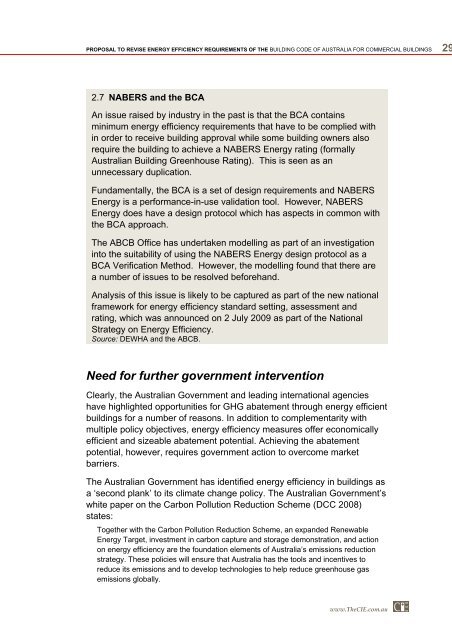PDF | 2 MB - Australian Building Codes Board
PDF | 2 MB - Australian Building Codes Board
PDF | 2 MB - Australian Building Codes Board
Create successful ePaper yourself
Turn your PDF publications into a flip-book with our unique Google optimized e-Paper software.
PROPOSAL TO REVISE ENERGY EFFICIENCY REQUIREMENTS OF THE BUILDING CODE OF AUSTRALIA FOR COMMERCIAL BUILDINGS 29<br />
2.7 NABERS and the BCA<br />
An issue raised by industry in the past is that the BCA contains<br />
minimum energy efficiency requirements that have to be complied with<br />
in order to receive building approval while some building owners also<br />
require the building to achieve a NABERS Energy rating (formally<br />
<strong>Australian</strong> <strong>Building</strong> Greenhouse Rating). This is seen as an<br />
unnecessary duplication.<br />
Fundamentally, the BCA is a set of design requirements and NABERS<br />
Energy is a performance-in-use validation tool. However, NABERS<br />
Energy does have a design protocol which has aspects in common with<br />
the BCA approach.<br />
The ABCB Office has undertaken modelling as part of an investigation<br />
into the suitability of using the NABERS Energy design protocol as a<br />
BCA Verification Method. However, the modelling found that there are<br />
a number of issues to be resolved beforehand.<br />
Analysis of this issue is likely to be captured as part of the new national<br />
framework for energy efficiency standard setting, assessment and<br />
rating, which was announced on 2 July 2009 as part of the National<br />
Strategy on Energy Efficiency.<br />
Source: DEWHA and the ABCB.<br />
Need for further government intervention<br />
Clearly, the <strong>Australian</strong> Government and leading international agencies<br />
have highlighted opportunities for GHG abatement through energy efficient<br />
buildings for a number of reasons. In addition to complementarity with<br />
multiple policy objectives, energy efficiency measures offer economically<br />
efficient and sizeable abatement potential. Achieving the abatement<br />
potential, however, requires government action to overcome market<br />
barriers.<br />
The <strong>Australian</strong> Government has identified energy efficiency in buildings as<br />
a ‘second plank’ to its climate change policy. The <strong>Australian</strong> Government’s<br />
white paper on the Carbon Pollution Reduction Scheme (DCC 2008)<br />
states:<br />
Together with the Carbon Pollution Reduction Scheme, an expanded Renewable<br />
Energy Target, investment in carbon capture and storage demonstration, and action<br />
on energy efficiency are the foundation elements of Australia’s emissions reduction<br />
strategy. These policies will ensure that Australia has the tools and incentives to<br />
reduce its emissions and to develop technologies to help reduce greenhouse gas<br />
emissions globally.<br />
www.TheCIE.com.au
















